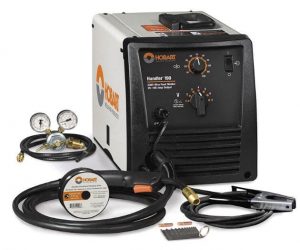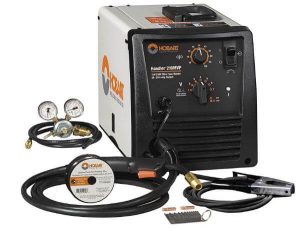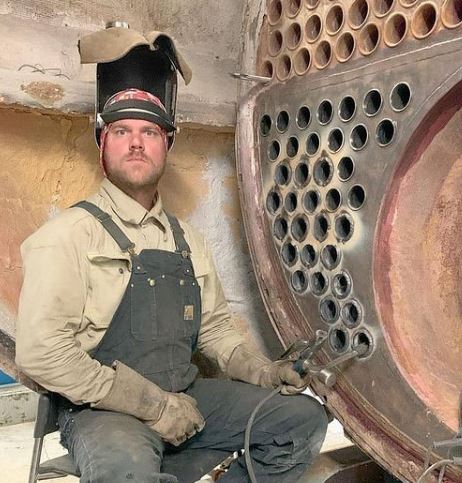Choosing the right welder between the two is becomes a tricky task while it comes to choose between Hobart 190 vs 210. Hobart is a well-known brand with a wide range of welders, safety gears, and cutting equipment.
190 is a MIG welder capable enough to deliver up to 190A output while using 230V. The other is 210 MVP; it delivers 115V or 230V input voltage and offers higher 210A output amperage. Both machines are easily transportable, versatile, and affordable, making it challenging to choose the best.

Comparison
Here is a quick view of both products for quick analysis. The following comparison table is based on Metal Thickness Capacity, Power, Duty Cycle, Thermal Overload Protection, Warranty, and Portability.
Check out this comparison table of Hobart 190 and 210;
Hobart 190 | Hobart 210 MPV |
|---|---|
Auto body | Auto body |
Metal art | Metal art |
DIY hobbyist | Boat/marine, Light fabrication |
Home maintenance/repair | Home maintenance/repair |
Weight: 60 LB/30.8 KG | Weight: 79 LB/35.8 KG |
Duty Cycle: 30% @ 130A | Duty Cycle: 30% @ 150A, 20% at 90A |
Warranty: 3 YEAR | Warranty: 3 YEAR |
Output Amperage: 190A | Output Amperage: 210A |
Max Material Thickness: 5/16″ STEEL | Max Material Thickness: 3/8″ STEEL |
Hobart 190 vs 210
Hobart 210 machine’s welding range is between 24-gauge (0.6 mm) sheets and 3/8 inch (9.6 mm) on thick metals. Its versatility makes it more suitable for operating with thinner metals.
1- Metal Thickness Capacity
While talking about the maximum welding thickness, the experts always suggest a single pass. These welders can weld thicker to thicker material with various keys.
When purchasing a welder, a Hobart welder should consider the thickness of the metal and the material. Take note of the minimum and maximum thickness of the metal and material.
Hobart 190 comes within 24-gauge (0.6 mm) and 5/16 inch (8.0 mm) welding range in a single pass while working with steel. Always pay attention while changing to the low setting amperage to avoid holes meanwhile connecting thinner panels. 
Final Thoughts
There is almost no difference between the welding thickness ranges of the two Hobart units, but the 210 provides a better option for welding thin and thick metals at the same time.
Different metals have different values, of course. Stainless Steel and Aluminum user manuals provide the appropriate settings for the materials.
2- Power Capacity
It is essential to buy any machine to identify the input voltage needed to operate that particular machine. Always consider those machines which perfectly compatible with standard household outlets or generators.
Hobart 190 only works on 230v power. it requires a generator if practiced in a house with a 115V power outlet. And keep in mind, it will only work with those generators that produce at least 7,000 Watt. But it has wide amperage output with between 25A and 190A range.
On the other hand, Hobart 120 works on both primary voltage (115v,230v). The amperage output is within 25A and 210A on 230V and within 25A and 140A on 115V.
It is the best option for the thinner materials and provides better performance on lighter materials at 115V. Also works perfectly on thicker materials at 230V for all heavy-duty tasks.
Final Thoughts
The Hobart 210 is thus more versatile since it can be operated at either 115V or 230V, while the model 190 can only work at 230V. Accordingly, it is considered among the best 220V welding machines.
Even though Hobart 190 welding machines can only be powered by 230V, their amperage range still makes them quite versatile. It is able to weld thin as well as thick metals.
3- Duty Cycle
190 welding machine comes with a 30% duty cycle at 130A that indicates that it can perfectly weld for 3 minutes, then it requires 7 minutes for rest.
But the Hobart 210 MPV has a 30% duty cycle at 150A on 230V and 20% at 90A while plugged on 115V. When it works on 115V, it can weld for two minutes; then, it needs 8 minutes to rest. When it operates on 230V, it can run for 3 minutes; it needs 7 minutes to rest.
Final Thoughts
Hobart 190 and 210 have slight differences in duty cycles based on the comparison. Each unit has a 30% duty cycle and a similarly good performance when operated on 230 volts.

4- Portability
Portability level always depends on weight and size. A lightweight welding machine will be less potent than any heavy device. The 210 model weight is around 79 lb, and the 190 weight is 68 pounds.
The first one is a bit heavier than to others, but both are portable units. These are easy to move from one place to another. One of this machine’s best features is working from a dynamo with about 7,000 running watts. This machine can operate at job sites without any power.
5- Thermal Overload Protection
Thermal over protection is one of the essential features in any welding unit. Both Hobart 190 and 210 come with thermal overload protection, automatically turning off the welding device while the device touches its peak duty cycle. It makes the unit cool to get back to work without any damage.
It gets back to the welding when the machine deems itself cool to operate without damaging its internal parts. This device offers seven voltage options, enhanced magnets, and variable wire feed speeds to control output parameters more finely and reduce spattering the best tig welder for the aluminium task.
6- Warranty
Both 190 and 210 units come with a three-year money-back warranty, but the MIG guns covered one year. Material Thickness and Output Amperage is the best part of these models.
Hobart Handler 190 Specifications
- Weight: 89 pounds
- Dimensions: 29.5 x 18.5 x 13.7 inches
- Size: Large
- 30% duty cycle
- 130 Amps.Open Circuit Voltage:31
- 25 to 190 output amperage
- Welds 24 ga. to 5/16 in. steel
- Material: Steel
- Seven output voltage settings
- 150 Amp Spool Gun
- 10-ft work cable & clamp
- 10-ft power cord
- Extra. 030 contact tips
- 030 flux-cored wire
- 8-inch spool adapter
- Warranty: Standard 5/3/1
Hobart Handler 210 Specifications
- Dimensions: 10.62” W x 19.5” L x 12.37” H
- Welder weight: 79 lbs.
- Size: Small
- Installation Method: Gas-welding
- Input Voltage: 110/115/120 V – 220/230/240 V
- Material Thickness: 1/4″ – 3/8
- Power to weld 3/8 in. mild steel
- 10-Feet (3-meter) H100S4-10 gun
- 10-Feet (3-meter) work cable
- Four or 8-Inch spools
- Sample spool of 0.030-Inch (0.8-mm
- Flux-cored wire 0.030-Inch (0.8 mm) contact tips
- 10-Feet (3-meter) power cord
- Warranty: 3-year limited warranty
- 5-15P (115 V, 15 A) and 6-50P (230 V, 50 A) MVP plugs
Similarities
when the brand is the same, then similarities must exist between them. Let’s move forward.
It is possible to carry both welding devices around to one’s home or a job site. With a bit of effort, either one of the devices can quickly move. Both the machines are suited to auto bodywork, and There’s a handle built-in Hobart 190 that facilitates it even better.
A notable similarity between the two machines is the fact both can run on 230 volts. A contact tip can weld thick metals together by cutting them. There is no possibility of warping or distorted metals. Keep the welding torch correctly held while MIG welding. Also check out Miller 200 vs 215 for more upgraded features like this.
There are seven taps in the voltage control system in both machines. It offers fine-tune welding to matches the expectations of all welders with their infinite loop control and a fast wire speed.
Both the machines’ control panels are the same for the seven-tap system and the spool gun. No extensive manual is needed to understand what the makers placed there.
10 feet is the total length of both the power cord and the cord for the MIG welding gun. Consequently, they both offer us the same degree of manoeuvrability when it comes to manoeuvrability. Among these machines, even the accessories are the same. There is no bid distinction between the two.
Applications
190 Hobart
- Metal art
- Auto body
- DIY hobbyist
- Home maintenance/repair
210 MPV by Hobart
- Metal art
- Boat/marine
- Auto body
- Light fabrication
- Home maintenance/repair
Differences
After discussing the similarities in detail, Let’s talk about some differences. Still, they are also very different from one another. Firstly, let’s examine them side-by-side.
Parameters | 190 | 210 |
|---|---|---|
Manufactured In | USA | USA |
Welder Type | MIG, Flux-core | MIG, Flux-core |
Amperage | 25 – 190A | 25-210A |
Output Range | 25 – 190 Amps | 25 – 210 Amps |
Voltage Control | 7 Positions | 7 (230V) & 4 (115V) Positions |
Duty Cycle | 30% @ 130 A (21.5V) | 20% Duty cycle at 90 amps 30% @ 150A (23V) |
Wire Feed Speed Control | Infinite | Infinite |
Input Voltage | 220/230/240 V | 110/115/120 V & 220/230/240 V |
Wire Spool Sizes | 4-in. and 8-in | 4-in. and 8-in |
Weldable Materials | Mild Steel, Stainless, Aluminum | Mild Steel, Stainless, Aluminum |
Wire Feed Speed | 40-740 ipm | 40-770 ipm |
Product Weight | 68 lbs. | 79 lbs. |
Welder Dimensions (H x W x L) | 12.375 in. x 10.625 in. x 19.5 in. | 12.375 in. x 10.625 in. x 19.5 in. |
Wire Thickness | 0.023 – 0.035 in. solid wire | 0.023 – 0.035 in. solid wire (0.030 – 0.045 in. flux-cored wire) |
Mild Steel Thickness (Single-pass) | 24 gauge to 5/16 in. | 24 gauge – 3/8 in. |
Warranty | 5/3/1 years | 5/3/1 years |
Duty Cycle
The Duty cycle refers to the maximum time a welding machine is capable of running. It should take a break before it does. While comparing operating time and cool-down periods for these two tools, they are close to each other.
Using 115V, the Hobart 210 MVP operates for two minutes before it rests for eight. In 230V mode, the motor runs for 3 minutes straight before rest for 7 minutes. The duty cycle for 11V is 20%, whereas the duty cycle for 230V is 30%.
Cutting Metals
The 210 MVP can easily cut metals ranging from 24ga to 3/8 in thickness. A metal sheet, a metal bar, or a metal beam would be ideal. Still, Hobart 190 isn’t that far behind. People can cut metal up to a thickness of 5/16 inches with a 24ga gauge.
Secondly, the “Dual-Voltage” concept also plays a part here. The 210 MVP is a versatile unit as there are several voltage settings available.
Metals with low and high melting points can be cut and welded with this machine.
They are only able to weld and cut high melting-point metals. Hobart’s MVP for 210 also deserves mention here. Versatility is its most significant advantage.
Power Consumption Stacks up
It’s easy to see which is more versatile here with the naked eye. The Hobart MVP 210 runs on both 115V and 230V, and it can withstand up to seven different voltage levels. There are four different voltage settings at 115V.
The unit allows to accurately calculate how much power is needed to weld different metal components. Because of this, one can cut both thin and thick metals.
Unlike Hobart, the Handler 190 requires 230V to weld. A Hobart 190 generator works well with 7000-watt running generators. Although still only thicker metals can weld with this machine.
FAQ’s
Is it necessary to shield with a gas?
Using Hobart 210 with Flux wire allows to weld metal without using gasoline. Shielding gas is required for the Hobart 190. Shielding gas is required for both machines because it keeps the molten weld pool from contacting airborne oxygen and hydrogen.
Is there a spool gun included with Hobart 190 machines?
Packages vary according to their type. A MIG gun is included in one box, whereas another comes with a MIG gun and a spool gun.
Which safety equipment is most important?
There are several safety precautions to take:
- Helmet for welding. This type of protective equipment provides radiation and spark protection.
- Wear a protective jacket. Heavy-duty and medium-duty jackets provide resistance to flames.
- Put on gloves. Radiation and intense heat can damage the hand, which is protected with gloves.
- Wear aprons. Their purpose is to give chest and leg protection.
- Footwear. The extra protection they provide makes the feet feel more secure. Heavy objects will not strike the foot.
- Wear respiratory protection. The use of respirators prevents your lungs from being inundated with a medley of toxic fumes caused by melting metals.
Are these machines worth investing in?
As we have discussed, the TIG welder can do a lot more than TIG welders, so they might not be the best option if combining welding porn with exotic materials.
A 220V outlet is needed for them; otherwise, they are suitable for almost anyone. The shop does both professional and beginner welding. Because of how many projects they can weld, the average person is not likely to ever use all the welders’ capabilities.
Do they have a warranty?
A 3-year warranty should cover the wire feeding systems and PC-boards on both of these machines. Transformers and stabilizers come with a 5-year warranty. Lastly, welding guns come with a year’s contract. The decision to buy from a particular supplier makes a difference as well. Depending on the reseller rules, the terms might vary.
Conclusions
So, it is hard to decide between Hobart 210 and 190 which of the two would be the best welding device. Both machines perform well as they have the option to perform on both 115V and 230V outlets. It allows performing in various settings at different power levels. So it’s all up to the user to decide according to their preferences.
In the welding industry, Hobart Welders is known for its ability to create quality welding equipment.
Hobart is a wise choice when it comes to purchasing a welding machine because it gives one of the best services available.

It’s been years since I got into welding as a side hustle. It’s been so long since Doing All kinds of welds for business and pleasure as this is my hobby. Being in this field I have learned from hands-on-experience also came to know what gears work and what doesn’t. The Tig Welder is my own platform where I use to share my experience.
Leave a Reply